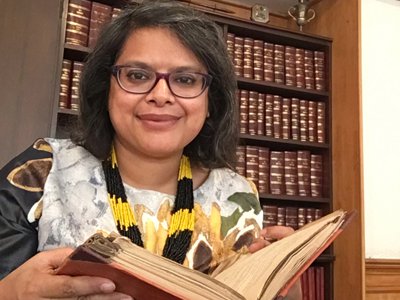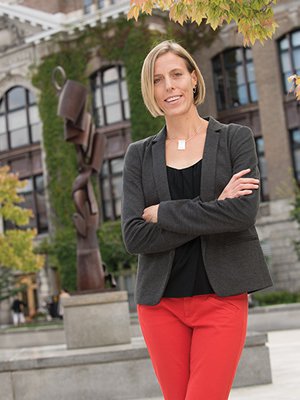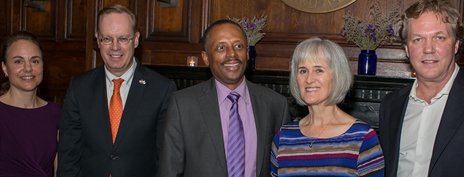Creative Conversations: Faculty Research in the Humanities (Part I)
Humanistic research thrives at Syracuse, thanks to collaborations with artists, scientists, engineers, librarians

Last fall, Romita Ray, an art historian in the College of Arts and Sciences (A&S), launched a series of panel discussions called “Creative Conversations.” Interdisciplinary in scope, the inaugural event focused on the interplay between water and photography to show how science, art and the humanities are tightly interwoven.
The salon featured an animated discussion between Jeffrey Karson, a marine geologist in A&S, and the husband-and-wife team of Edward Morris and Susannah Sayler, artist-activists in the College of Visual and Performing Arts (VPA). The session spanned all manner of topics—from Karson’s involvement with the award-winning book “Discovering the Deep: A Photographic Atlas of the Seafloor and Ocean Crust” (Cambridge University Press, 2015) to Morris and Sayler’s founding of the Canary Project, which develops research-based art and media focusing on ecology. Ray nimbly connected the dots, reiterating how humanistic discourse, artistic practice and scientific research are not separate activities, but are part of the same lifelong pursuit of understanding.

“Syracuse is filled with outstanding professors whose research interests overlap, albeit in many different ways,” says Ray, associate professor of art history and chair of the Department of Art and Music Histories (AMH), during a recent meeting. “I want students to see how the sciences, arts and humanities work together to form a holistic liberal arts experience, which is part of Syracuse’s core mission.”
Sayler, whose images of embattled landscapes hang in art and science museums around the world, considers the arts and sciences “complementary.” “We believe art makes a space for belief, and belief makes a space for change,” says the associate professor of art photography and transmedia core, who, with Morris, also directs the Canary Lab. “Art’s function is not to decorate science or communicate it in a more fun way. Art is another form of knowledge.”
Such dialogue is nothing new. In fact, historians know these kinds of conversations took place thousands of years ago. As the competition for resources often forces institutions to adopt a silo mentality, the need for collaborative thinking is more imperative than ever. “Having conversations across the disciplines is key,” Ray says. “It starts with getting people from different backgrounds—artists, scientists, humanists, engineers, computer scientists, librarians—to rally around a common interest. At Syracuse, these exciting conversations happen in the humanities division of A&S.”

Faculty research is not just a core value; it is a necessity. Research excellence often raises an institution’s profile, leading to more public funding. This certainly is the case at Syracuse, where professors subscribe to high standards of productivity, impact and quality. Individual and group research does not just affect promotion and tenure; it reshapes the University’s academic agenda.
One of the hypocenters for such activity is the 120-year-old Tolley Humanities Building. Built in 1888 to house the library of the German historian Leopold von Ranke (the father of modern “professional” history writing), this symphony of brick and mortar has contained everything from the University’s first cafeteria to the Office of the Chancellor. Today, it is home to the Syracuse University Humanities Center, whose many programs and partnerships cultivate diverse forms of scholarship.
During a meeting in the recently renovated building, director Vivian May explains how humanities centers are relatively new in higher education. “These centers and institutes started popping up in the 1970s and ’80s as incubators for interdisciplinary research that could not be adequately housed in one departmental or disciplinary home,” she says, noting that Syracuse’s center celebrates its 10th anniversary in the fall of 2018. “Most centers, ours included, serve as the public face of the humanities, fostering research and curricular innovation. The work often is collaborative in nature, and, because it weaves itself into the fabric of the wider community, the center helps underscore the humanities as a public good.”
Every year, the Humanities Center offers several faculty and graduate student fellowships, visiting professorships and residencies. One of this year’s faculty fellows is Radha Kumar, assistant professor of history in the Maxwell School, who specializes in colonial and postcolonial South Asia. She is using her fellowship to work on an article titled “Police, Everyday Violence and Governmentality in Colonial India.”
“I want to contribute to a broader literature that delineates the colonial configuration of modern forms of power,” says Kumar, who joined the Maxwell faculty in 2014. “My project examines policing not simply as state authority exercised on passive populations, but also as spatial practice blurring the line between state and society. I argue that policing was simultaneously constitutive of the everyday authority of the state and of popular politics.”

Humanities research can be disciplinary, as well as interdisciplinary and collaborative. Take Sascha Scott, a colleague of Ray’s who is working on a book titled “Modern Pueblo Painting: Art, Colonization and Aesthetic Agency.” She says that interacting with people outside one’s field is healthy, if not essential.
“It is good to have your ways of doing things questioned and your assumptions tested. Sometimes, outside scholars do not buy into things that you take for granted, which pushes you to clarify or revise your thinking,” says Scott, a Humanities Center faculty fellow working at the nexus of art history, anthropology and Native American and indigenous studies. “Interdisciplinary work comes with its challenges. It is difficult enough to get footing in the literature of your field. Quick and clever engagement with other fields runs the risk of poor work. ‘Interdisciplinarity’ cannot be a buzz word; it needs to be done with diligence and humility.”
Such is the work of Susan Schweik, a disability studies pioneer at the University of California (UC), Berkeley, who is this year’s Jeannette K. Watson Distinguished Visiting Professor in the Humanities at Syracuse. This spring, she participates in an array of discussions and activities under the heading of “Bodies of Evidence: Documenting/Representing Injustice, Confinement and Incarceration.”
An English professor and an associate dean of arts and humanities at UC Berkeley, Schweik is in exalted company. Previous Watson holders include writers Toni Morrison, Margaret Atwood and Saul Bellow; linguist Noam Chomsky; and political activist Angela Davis.
“Visiting professors expose our faculty to new ideas and perspectives,” May says. “This kind of engagement can happen formally or informally, sometimes around the water-cooler or the dinner table. It also can set the stage for joint research projects or international exchange opportunities. All of this fuels a greater sense of community at Syracuse, sparking innovation across the disciplines.” She cites the Humanities Center’s current involvement with the Disability Studies Program in the School of Education as being indicative of the humanities’ broad relevance and impact across the campus community.

Nowhere is this collaborative ethos more evident than in the Central New York (CNY) Humanities Corridor, a large-scale initiative funded by the Andrew W. Mellon Foundation. Since its inception in 2006, the Humanities Corridor has fostered cross-institutional partnerships and resource-sharing mechanisms in emerging and established scholarly fields, including philosophy, linguistics and digital humanities (i.e., scholarly activity utilizing computing or digital technologies). On average, some 3,500 professors, graduate students and community members annually participate in more than 200 events and activities.
The Humanities Corridor has been in the Humanities Center since the founding of the latter in 2008. “Everything we do is marked by our relationship with the Humanities Center and by the University’s broad vision for the humanities,” says founding director and principal investigator Gregg Lambert. “Some of our projects involve areas of study that may not necessarily be funding priorities at their respective institutions, but are important, impactful areas of inquiry. These collaborative projects help us redefine the possibilities of research, while challenging the age-old stereotype of a solo faculty member wading through stacks of books in a locked room.”
The Humanities Corridor supports both "core disciplinary and cutting-edge, interdisciplinary research" in the humanities, Lambert says. Its website reveals seven thematic “clusters,” each containing “working groups” of faculty from nine colleges and universities, including Syracuse, Cornell and the University of Rochester. Some of these groups have projects with no-nonsense titles, such as “The Chinese Quest for Modernity from the Religious Perspective” and “New Media Art Practice.”
In 2014, Lambert initiated a successful proposal to the Mellon Foundation to endow the Humanities Corridor in perpetuity. Today, endowments at Syracuse, Cornell and Rochester, totaling more than $6.5 million, have transformed the project into what former Mellon President Earl Lewis calls a "national model of regional consortia."
“The Humanities Corridor is one of the most highly endowed humanities programs in the country,” beams Lambert, adding that Mellon Foundation has awarded $5 million to Syracuse, alone, in the past decade. “Thanks to Mellon's support, we can provide scholarly residencies, graduate student fellowships and support for intra-corridor travel. This, in turn, creates a bevy of lectures, workshops, seminars, exhibitions, screenings, performances and publications.”
On the heels of the successful completion of the Humanities Corridor’s endowment is the establishment of a blue-chip advisory board. This 12-person group—comprising representatives from Syracuse, Cornell and Rochester, as well as Colgate, Hamilton and Le Moyne colleges—ensures collaborative research across the region. Says Lambert, “The Corridor Advisory Board serves as a direct line of communication with members of our participating institutions, encouraging new program ideas and suggestions.”
Karin Ruhlandt, dean of A&S and Distinguished Professor of Chemistry, observes the growing role of corporations and foundations in supporting humanities research. She says that, despite federal cuts, total research expenditures in the humanities in A&S were nearly $473,000 in FY2017—proof of the faculty’s ability to mine new, alternative forms of support.
“Our growth in humanities funding is almost identical to those in math and science,” Ruhlandt says. “Humanities funding may be smaller in magnitude, but it is valuable for recognition and support of research in which expenses are lower. … Thanks to the nimble innovation of our humanists and their engagement with the private sector [e.g., the Mellon Foundation], our research excellence in the humanities and the humanistic social sciences has never been stronger.”
Featured
Romita Ray Associate Professor and Director of Undergraduate Studies in Art History
Vivian M. May Professor
Sascha Scott Associate Professor
